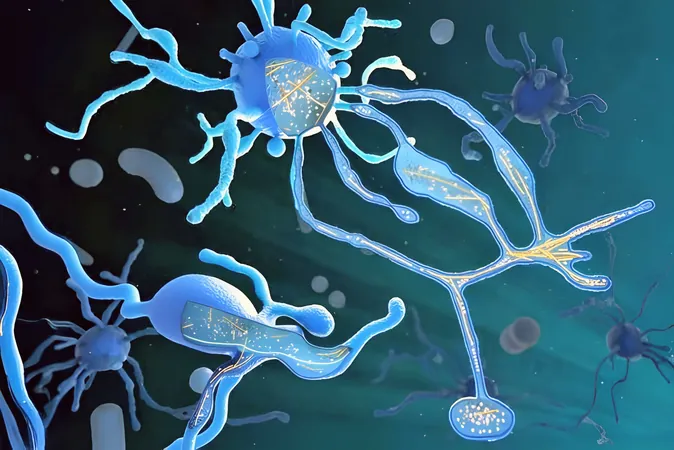
Tiny Microbes Spark Revolutionary Insights into the Origins of Complex Life!
2025-03-24
Author: Sarah
A decade ago, scientists were completely unaware of the existence of a fascinating group of microorganisms known as Asgard archaea. However, everything changed in 2015 when researchers examining deep-sea sediments uncovered mysterious gene fragments. Utilizing advanced computer software, they successfully reconstructed these fragments and unveiled a groundbreaking discovery—a previously unrecognized category of microbes.
Asgard archaea are single-celled organisms that are related to bacteria but distinct in their genetic make-up. They differ significantly from traditional bacteria in their cellular structures and energy-processing mechanisms. Given their uniqueness, scientists classified this newly identified group as Asgard archaea, drawing inspiration from Norse mythology, as their discovery was linked to the site near Loki’s Castle, a hydrothermal vent located in the mid-Atlantic Ocean.
From Microbes to Multicellular Marvels
The excitement around Asgard archaea does not stop with their discovery. Research suggests they may represent the closest living relatives of eukaryotes—organisms like humans, animals, and plants, whose cells contain a nucleus. This finding has prompted scientists to rethink the long-standing three-domain model of life, proposing instead that eukaryotes may have evolved from Asgard archaea. Consequently, this could simplify the tree of life, reducing it to just two fundamental domains: archaea and bacteria.
In recent studies conducted at ETH Zurich, researchers have delved into a specific species of Asgard archaea named Lokiarchaeum ossiferum, isolated from Slovenia’s brackish water channel sediments. Their investigations revealed remarkable characteristics of this microbe that are strikingly similar to those found in eukaryotic cells.
One significant finding was the discovery of a protein called Lokiactin, similar to actin proteins in eukaryotes, which plays a crucial role in cellular structure. This protein forms long, thin filaments that contribute to the microbe's cellular architecture, akin to a skeleton of tentacles.
The Cytoskeletal Connection to Evolution
Beyond actin, researchers from ETH Zurich found structures resembling microtubules, another essential component of eukaryotic cells. Microtubules function like highways for transporting materials within the cell and are vital during cell division. This discovery raised intriguing questions about the origins of these structures, as previously, scientists were unaware of their lineage.
Interestingly, while Lokiactin is abundant, proteins known as tubulins—responsible for forming microtubules—are scarce among Asgard species, leaving scientists puzzled about their rarity. Current research indicates that these tubulins may perform similar functions to microtubules in eukaryotic cells, suggesting a deeper evolutionary link.
Researchers believe that the cytoskeleton, or internal framework of the cells, may have been pivotal in the emergence of complex life. They speculate that ancient Asgard archaea might have utilized their tentacle-like appendages to capture other bacteria, which eventually evolved into organelles like mitochondria—the powerhouses of modern cells. This evolutionary leap laid the groundwork for developing eukaryotic cells that ultimately led to the great diversity of life we see on Earth today.
A Quest for Knowledge Continues
The team at ETH Zurich is not resting on their laurels. Their next steps include a deeper exploration of the roles of actin and tubulin in Asgard archaea, which could illuminate many of the unresolved questions about these enigmatic organisms. They aim to develop antibodies that would allow them to “fish” for Asgard archaea within complex microbial ecosystems, pushing the boundaries of our understanding even further.
The implications of this research extend beyond just understanding the past; they hold potential keys to unlocking secrets about the origins of complex life and the developmental processes that shaped it. With many questions still unanswered, the quest to unravel these microbial mysteries is an exciting frontier in biology.
As we continue to investigate the microscopic world, we may one day uncover the full significance of these tiny organisms. The journey into the depths of life's origins is only just beginning—who knows what we will discover next!
The complete findings of this study have been published in the renowned journal, Cell.



 Brasil (PT)
Brasil (PT)
 Canada (EN)
Canada (EN)
 Chile (ES)
Chile (ES)
 Česko (CS)
Česko (CS)
 대한민국 (KO)
대한민국 (KO)
 España (ES)
España (ES)
 France (FR)
France (FR)
 Hong Kong (EN)
Hong Kong (EN)
 Italia (IT)
Italia (IT)
 日本 (JA)
日本 (JA)
 Magyarország (HU)
Magyarország (HU)
 Norge (NO)
Norge (NO)
 Polska (PL)
Polska (PL)
 Schweiz (DE)
Schweiz (DE)
 Singapore (EN)
Singapore (EN)
 Sverige (SV)
Sverige (SV)
 Suomi (FI)
Suomi (FI)
 Türkiye (TR)
Türkiye (TR)
 الإمارات العربية المتحدة (AR)
الإمارات العربية المتحدة (AR)